View in other NatureServe Network Field Guides
NatureServe
Montana
Utah
Wyoming
Idaho
Wisconsin
British Columbia
South Carolina
Yukon
California
New York
White Sucker - Catostomus commersonii
State Rank Reason (see State Rank above)
Species is widespread and currently stable, but faces significant threats
General Description
The white sucker is quite adaptable. It has been collected from virtually all types of water in Montana: muddy, clear, warm, cold, running and standing. As the position of the mouth suggests, it feeds on the bottom and eats an omnivorous diet of detritus and insects. The white sucker is distributed throughout Montana's eastern drainage and is present in our northern watershed as well. They are most abundant in the many reservoirs of eastern Montana. In Montana the largest specimens have been about 5 pounds. Large females can produce over 100,000 eggs and suckers can produce large populations in short periods of time. Any type of attempted population control by man is usually a losing proposition. (FWP) See Snyder and Muth (1990) for a guide to the identification of larvae and early juveniles.
Diagnostic Characteristics
Color is dusky olive brown to nearly black above, shading to cream or white below. Dorsal fin has 11 to 13 rays. Scales are medium sized, 60 to 75 in lateral line.
Species Range
Montana Range
Range Descriptions
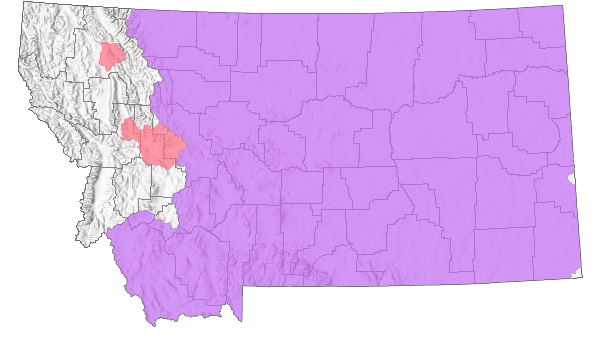 Western Hemisphere Range
Western Hemisphere Range

Observations in Montana Natural Heritage Program Database
Number of Observations: 6684
(Click on the following maps and charts to see full sized version)
Map Help and Descriptions
Relative Density
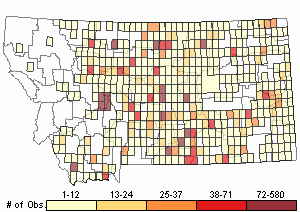
Recency
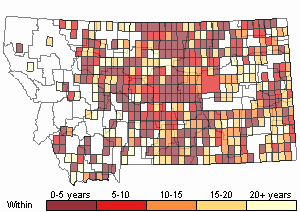
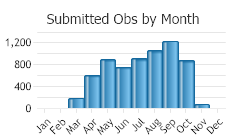
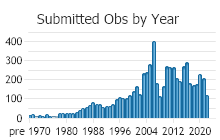
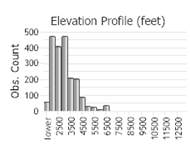 (Observations spanning multiple months or years are excluded from time charts)
(Observations spanning multiple months or years are excluded from time charts)
Migration
Often move into tributary streams to spawn. Tongue River study showed migration into Otter Creek.
Habitat
Extremely varied. Present in both lakes and streams under a wide variety of considerations, but avoids rapid current. Reaches maximum abundance in man-made impoundments. Spawns over gravel or rocky shoals.
Food Habits
Adults feed on bottom organisms such as aquatic invertebrate diatoms, other algae, and debris.
Ecology
Young provide considerable forage for game species. White sucker x longnose sucker hybrids have been found in several places in Montana.
Reproductive Characteristics
Sexually mature in 3rd or 4th year. Spawns from April into June. Spawners usually move upstream. Eggs hatch in 12-20 days at 50 degrees F. Spawned early April-early May in Tongue River study.
Stewardship Responsibility
References
- Literature Cited AboveLegend:
 View Online Publication
View Online Publication Lee, D.S., C.R. Gilbert, C.H. Hocutt, R.E. Jenkins, D. E. McAllister, J. R. Stauffer, Jr. 1980. Atlas of North American freshwater fishes. North Carolina State Musuem of Natural History. 867 p.
Lee, D.S., C.R. Gilbert, C.H. Hocutt, R.E. Jenkins, D. E. McAllister, J. R. Stauffer, Jr. 1980. Atlas of North American freshwater fishes. North Carolina State Musuem of Natural History. 867 p. Scott, W.B. and E.J. Crossman. 1973. Rainbow trout, Kamloops trout, Steelhead trout Salmo gairdneri Richardson. pp. 184-191. In: Freshwater fishes of Canada. Ottawa, Canada: Fisheries Research Board of Canada, Bulletin 184. 966 p.
Scott, W.B. and E.J. Crossman. 1973. Rainbow trout, Kamloops trout, Steelhead trout Salmo gairdneri Richardson. pp. 184-191. In: Freshwater fishes of Canada. Ottawa, Canada: Fisheries Research Board of Canada, Bulletin 184. 966 p. Snyder, D.E., and R.T. Muth. 1990. Description and identification of razorback, flannelmouth, white, Utah, bluehead, and mountain sucker larvae and early juveniles. Colorado Division of Wildlife Tech. Publ. No. 38. 152 pp.
Snyder, D.E., and R.T. Muth. 1990. Description and identification of razorback, flannelmouth, white, Utah, bluehead, and mountain sucker larvae and early juveniles. Colorado Division of Wildlife Tech. Publ. No. 38. 152 pp.
- Additional ReferencesLegend:
 View Online Publication
View Online Publication
Do you know of a citation we're missing? Barfoot, C.A. 1993. Longitudinal distribution of fishes and habitat in Little Beaver Creek, Montana. M.Sc. Thesis. Bozeman, MT: Montana State University. 66 p.
Barfoot, C.A. 1993. Longitudinal distribution of fishes and habitat in Little Beaver Creek, Montana. M.Sc. Thesis. Bozeman, MT: Montana State University. 66 p. Barfoot, C.A. and R.G. White. 1999. Fish assemblages and habitat relationships in a small northern Great Plains stream. The Prairie Naturalist 31(2):87-107.
Barfoot, C.A. and R.G. White. 1999. Fish assemblages and habitat relationships in a small northern Great Plains stream. The Prairie Naturalist 31(2):87-107. Barndt, S.A. 1996. The Biology and Status of the Arctic Grayling in Sunnyslope Canal, Montana. M.Sc. Thesis. Bozeman, MT: Montana State University. 136 p.
Barndt, S.A. 1996. The Biology and Status of the Arctic Grayling in Sunnyslope Canal, Montana. M.Sc. Thesis. Bozeman, MT: Montana State University. 136 p. Clancey, C.G. 1978. The fish and aquatic invertebrates in Sarpy Creek, Montana. M.Sc. Thesis. Bozeman, MT: Montana State University. 54 p.
Clancey, C.G. 1978. The fish and aquatic invertebrates in Sarpy Creek, Montana. M.Sc. Thesis. Bozeman, MT: Montana State University. 54 p. Clothier, W.D. 1952. Fish loss and movement in irrigation diversions from the West Gallatin River, Montana. M.Sc. Thesis. Bozeman, MT: Montana State University. 32 p.
Clothier, W.D. 1952. Fish loss and movement in irrigation diversions from the West Gallatin River, Montana. M.Sc. Thesis. Bozeman, MT: Montana State University. 32 p. Craig, V.E. 1952. A story of fish production as it applies to Montana. M.Sc. Thesis. Bozeman, MT: Montana State University. 92 p.
Craig, V.E. 1952. A story of fish production as it applies to Montana. M.Sc. Thesis. Bozeman, MT: Montana State University. 92 p. Dieterman, D.J., M.P. Ruggles, M.L. Wildhaber, and D.L. Galat (eds). 1996. Population structure and habitat use of benthic fishes along the Missouri and Lower Yellowstone Rivers. 1996 Annual report of Missouri River Benthic Fish Study PD-95-5832 to U.S. Army Corps of Engineers and U.S. Bureau of Reclamation. 238 p.
Dieterman, D.J., M.P. Ruggles, M.L. Wildhaber, and D.L. Galat (eds). 1996. Population structure and habitat use of benthic fishes along the Missouri and Lower Yellowstone Rivers. 1996 Annual report of Missouri River Benthic Fish Study PD-95-5832 to U.S. Army Corps of Engineers and U.S. Bureau of Reclamation. 238 p. Duncan, M.B. 2019. Distributions, abundances, and movements of small, nongame fishes in a large Great Plains river network. Ph.D. Dissertation. Bozeman, MT: Montana State University. 255 p.
Duncan, M.B. 2019. Distributions, abundances, and movements of small, nongame fishes in a large Great Plains river network. Ph.D. Dissertation. Bozeman, MT: Montana State University. 255 p. Elser, A.A. 1967. Fish population of a trout stream in relation to major habitat zones and channel alterations. M.Sc. Thesis. Bozeman, MT: Montana State University. 27 p.
Elser, A.A. 1967. Fish population of a trout stream in relation to major habitat zones and channel alterations. M.Sc. Thesis. Bozeman, MT: Montana State University. 27 p. Endicott, C.L. 1996. Responses of riparian and stream ecosystems to varying timing and intensity of livestock grazing in central Montana. M.Sc. Thesis. Bozeman, MT: Montana State University. 115 p.
Endicott, C.L. 1996. Responses of riparian and stream ecosystems to varying timing and intensity of livestock grazing in central Montana. M.Sc. Thesis. Bozeman, MT: Montana State University. 115 p. Gangloff, M.M. 1996. Winter habitat and distribution of Artic Grayling in Upper Red Rock Lake, Red Rock Lakes National Wildlife Refuge, Montana. M.Sc. Thesis. Bozeman, MT: Montana State University. 101p.
Gangloff, M.M. 1996. Winter habitat and distribution of Artic Grayling in Upper Red Rock Lake, Red Rock Lakes National Wildlife Refuge, Montana. M.Sc. Thesis. Bozeman, MT: Montana State University. 101p. Gilham, A.T. 2016. Relationship between intensity of livestock grazing and trout biomass in headwaters of east front rocky mountain streams, Montana. M.Sc. Thesis. Bozeman, MT: Montana State University. 45 p.
Gilham, A.T. 2016. Relationship between intensity of livestock grazing and trout biomass in headwaters of east front rocky mountain streams, Montana. M.Sc. Thesis. Bozeman, MT: Montana State University. 45 p. Gustafson, D. L. 1990. Ecology of aquatic insects in the Gallatin River drainage. Ph.D. Dissertation. Bozeman, MT: Montana State University. 194 p.
Gustafson, D. L. 1990. Ecology of aquatic insects in the Gallatin River drainage. Ph.D. Dissertation. Bozeman, MT: Montana State University. 194 p. Hendricks, P., S. Lenard, D.M. Stagliano, and B.A. Maxell. 2013. Baseline nongame wildlife surveys on the Fort Peck Indian Reservation. Report to the Assiniboine and Sioux Tribes of the Fort Peck Indian Reservation. Montana Natural Heritage Program, Helena, MT. 83 p.
Hendricks, P., S. Lenard, D.M. Stagliano, and B.A. Maxell. 2013. Baseline nongame wildlife surveys on the Fort Peck Indian Reservation. Report to the Assiniboine and Sioux Tribes of the Fort Peck Indian Reservation. Montana Natural Heritage Program, Helena, MT. 83 p. Jeanes, E.D. 1996. Behavioral responses to water current of age-0 Arctic Grayling from the Madison River, and their use of stream habitat. M.Sc. Thesis. Bozeman, MT: Montana State University. 60p.
Jeanes, E.D. 1996. Behavioral responses to water current of age-0 Arctic Grayling from the Madison River, and their use of stream habitat. M.Sc. Thesis. Bozeman, MT: Montana State University. 60p. Joslin, Gayle, and Heidi B. Youmans. 1999. Effects of recreation on Rocky Mountain wildlife: a review for Montana. [Montana]: Montana Chapter of the Wildlife Society.
Joslin, Gayle, and Heidi B. Youmans. 1999. Effects of recreation on Rocky Mountain wildlife: a review for Montana. [Montana]: Montana Chapter of the Wildlife Society. Kathrein, J.W. 1950. A partial fisheries survey of the Missouri River between Holter Dam and Cascade, Montana, with special emphasis on growth rate of trout and suckers. M.Sc. Thesis. Bozeman, MT: Montana State University. 27 p.
Kathrein, J.W. 1950. A partial fisheries survey of the Missouri River between Holter Dam and Cascade, Montana, with special emphasis on growth rate of trout and suckers. M.Sc. Thesis. Bozeman, MT: Montana State University. 27 p. Katzman, L.A. 1998. Effects of predation on status of Arctic grayling at Red Rock Lakes National Wildlife Refuge, Montana. M.Sc. Thesis. Bozeman, MT: Montana State University. 207 p.
Katzman, L.A. 1998. Effects of predation on status of Arctic grayling at Red Rock Lakes National Wildlife Refuge, Montana. M.Sc. Thesis. Bozeman, MT: Montana State University. 207 p. Knight, D.E. 1982. Accumulation of dietary methylmercury by Walleye and White Crappie in the Tongue River Reservoir, Montana. M.Sc. Thesis. Bozeman, Montana: Montana State University. 103 p.
Knight, D.E. 1982. Accumulation of dietary methylmercury by Walleye and White Crappie in the Tongue River Reservoir, Montana. M.Sc. Thesis. Bozeman, Montana: Montana State University. 103 p. Lance, M.J. 2019. Spatial and temporal variability in movements and vital rates of sympatric salmonids in an unfragmented, inland watershed. M.Sc. Thesis. Bozeman, MT: Montana State University. 116 p.
Lance, M.J. 2019. Spatial and temporal variability in movements and vital rates of sympatric salmonids in an unfragmented, inland watershed. M.Sc. Thesis. Bozeman, MT: Montana State University. 116 p. Lewis, S.L. 1967. Physical factors influencing fish populations in pools of a trout stream. M.Sc. Thesis. Bozeman, MT: Montana State University. 34 p.
Lewis, S.L. 1967. Physical factors influencing fish populations in pools of a trout stream. M.Sc. Thesis. Bozeman, MT: Montana State University. 34 p. Liermann, B.W. 2001. An evaluation of the reintroduction of fluvial Arctic Grayling into the upper Ruby River. M.Sc. Thesis. Bozeman, MT: Montana State University. 91 p.
Liermann, B.W. 2001. An evaluation of the reintroduction of fluvial Arctic Grayling into the upper Ruby River. M.Sc. Thesis. Bozeman, MT: Montana State University. 91 p. Logan, S.M. 1961. Winter observations on trout and bottom organisms in Bridger Creek, southwestern Montana. M.Sc. Thesis. Bozeman, MT: Montana State University. 30 p.
Logan, S.M. 1961. Winter observations on trout and bottom organisms in Bridger Creek, southwestern Montana. M.Sc. Thesis. Bozeman, MT: Montana State University. 30 p. Magnan, P. 1988. Interactions between brook charr, Salvelinus fontinalis, and nonsalmonid species: ecological shift, morphological shift, and their impact on zooplankton communities. Can. J. Fish. Aquat. Sci. 45:999-1009.
Magnan, P. 1988. Interactions between brook charr, Salvelinus fontinalis, and nonsalmonid species: ecological shift, morphological shift, and their impact on zooplankton communities. Can. J. Fish. Aquat. Sci. 45:999-1009. Marcoux, R.G. 1969. Fish populations in Big Spring Creek, Montana. M.Sc. Thesis. Bozeman, Montana: Montana State University
Marcoux, R.G. 1969. Fish populations in Big Spring Creek, Montana. M.Sc. Thesis. Bozeman, Montana: Montana State University Mogen, J.T. 1996. Status and biology of the spawning population of Red Rock Lakes Arctic grayling. M.Sc. Thesis. Bozeman, MT: Montana State University. 90 p.
Mogen, J.T. 1996. Status and biology of the spawning population of Red Rock Lakes Arctic grayling. M.Sc. Thesis. Bozeman, MT: Montana State University. 90 p. Montana Department of Fish, Wildlife and Parks. 1989. Northeast Montana Warmwater Ecosystem Investigations: project period 7/1/88 through 6/30/89. Proj.# F-46-R-2; Job# V-e. 21p.
Montana Department of Fish, Wildlife and Parks. 1989. Northeast Montana Warmwater Ecosystem Investigations: project period 7/1/88 through 6/30/89. Proj.# F-46-R-2; Job# V-e. 21p. Montana Fish, Wildlife and Parks. 1989. Hauser Reservoir fisheries management plan: September 1989-September 1994. 16 p.
Montana Fish, Wildlife and Parks. 1989. Hauser Reservoir fisheries management plan: September 1989-September 1994. 16 p. Mullins, M.S. 1991. Biology and predator use of cisco (Coregonus artedi) in Fort Peck Reservoir, Montana. M.Sc. Thesis. Bozeman, MT: Montana State University. 68 p.
Mullins, M.S. 1991. Biology and predator use of cisco (Coregonus artedi) in Fort Peck Reservoir, Montana. M.Sc. Thesis. Bozeman, MT: Montana State University. 68 p. Nelson, F.A. 1976. The effects of metals on trout populations in the Upper Boulder River, Montana. M.Sc. Thesis. Bozeman, MT: Montana State University. 60 p.
Nelson, F.A. 1976. The effects of metals on trout populations in the Upper Boulder River, Montana. M.Sc. Thesis. Bozeman, MT: Montana State University. 60 p. Nelson, P.H. 1953. Life history and management of the American Grayling (Thymallus signifer tricolor) in Montana. M.Sc. Thesis. Bozeman, MT: Montana State University. 45 p.
Nelson, P.H. 1953. Life history and management of the American Grayling (Thymallus signifer tricolor) in Montana. M.Sc. Thesis. Bozeman, MT: Montana State University. 45 p. Novak, M.A. 1988. Impacts of a fire-flood event on physical and biological characteristics of a small mountain stream. M.Sc. Thesis. Bozeman, MT: Montana State University. 98 p.
Novak, M.A. 1988. Impacts of a fire-flood event on physical and biological characteristics of a small mountain stream. M.Sc. Thesis. Bozeman, MT: Montana State University. 98 p. Penkal, R.F. 1977. Black bass populations of the Tongue River Reservoir, Montana. M.Sc. Thesis. Bozeman, MT: Montana State University. 111 p.
Penkal, R.F. 1977. Black bass populations of the Tongue River Reservoir, Montana. M.Sc. Thesis. Bozeman, MT: Montana State University. 111 p. Pierce, B.E. 1963. Distribution of fish in a small mountain stream in relation to temperature. M.Sc. Thesis. Bozeman, MT: Montana State University. 16 p.
Pierce, B.E. 1963. Distribution of fish in a small mountain stream in relation to temperature. M.Sc. Thesis. Bozeman, MT: Montana State University. 16 p. Posewitz, J.A. 1961. Observations on the fish population of Willow Creek reservoir, Montana. M.Sc. Thesis. Bozeman, MT: Montana State University. 29 p.
Posewitz, J.A. 1961. Observations on the fish population of Willow Creek reservoir, Montana. M.Sc. Thesis. Bozeman, MT: Montana State University. 29 p. Purkett, C.A. Jr. 1950. A comparative growth rate of trout in relation to elevation and temperature. M.Sc. Thesis. Bozeman, MT: Montana State University. 33 p.
Purkett, C.A. Jr. 1950. A comparative growth rate of trout in relation to elevation and temperature. M.Sc. Thesis. Bozeman, MT: Montana State University. 33 p. Reiland, E.W. 1997. Fish loss to irrigation canals and methods to reduce these losses on the West Gallatin River, Montana. M.Sc. Thesis. Bozeman, MT: Montana State University. 170 p.
Reiland, E.W. 1997. Fish loss to irrigation canals and methods to reduce these losses on the West Gallatin River, Montana. M.Sc. Thesis. Bozeman, MT: Montana State University. 170 p. Roberts, B.C. 1988. Potential influence of recreational use on Nelson Spring Creek, Montana. M.Sc. Thesis. Bozeman, MT: Montana State University. 79 p.
Roberts, B.C. 1988. Potential influence of recreational use on Nelson Spring Creek, Montana. M.Sc. Thesis. Bozeman, MT: Montana State University. 79 p. Rosenthal, L.R. 2007. Evaluation of distribution and fish passage in relation to road culverts in two eastern Montana prairie streams. M.Sc. Thesis. Bozeman, MT: Montana State University. 78 p.
Rosenthal, L.R. 2007. Evaluation of distribution and fish passage in relation to road culverts in two eastern Montana prairie streams. M.Sc. Thesis. Bozeman, MT: Montana State University. 78 p. Sando, S.K. 1981. The spawning and rearing habitats of rainbow trout and brown trout in two rivers Montana. M.Sc. Thesis. Bozeman, MT: Montana State University. 67 p.
Sando, S.K. 1981. The spawning and rearing habitats of rainbow trout and brown trout in two rivers Montana. M.Sc. Thesis. Bozeman, MT: Montana State University. 67 p. Schultz, L.P. 1941. Fishes of Glacier National Park, Montana. USDI Conservation Bulletin No. 22. Washington D.C.: US Government Printing Office. 42 p.
Schultz, L.P. 1941. Fishes of Glacier National Park, Montana. USDI Conservation Bulletin No. 22. Washington D.C.: US Government Printing Office. 42 p. Sloat, M.R. 2001. Status of westslope cutthroat trout in the Madison River basin: the influence of dispersal barriers and stream temperature. M.Sc. Thesis. Bozeman, MT: Montana State University. 118 p.
Sloat, M.R. 2001. Status of westslope cutthroat trout in the Madison River basin: the influence of dispersal barriers and stream temperature. M.Sc. Thesis. Bozeman, MT: Montana State University. 118 p. Spinelli, J.P. 2010. Spatial and temporal entrainment of fish from Hauser Reservoir, Montana. M.Sc. Thesis. Bozeman, Montana: Montana State University. 107 p.
Spinelli, J.P. 2010. Spatial and temporal entrainment of fish from Hauser Reservoir, Montana. M.Sc. Thesis. Bozeman, Montana: Montana State University. 107 p. Stash, S.W. 2001. Distribution, relative abundance, and habitat associations of Milk River fishes related to irrigation diversion dams. M.Sc. Thesis. Bozeman, MT: Montana State University. 82 p.
Stash, S.W. 2001. Distribution, relative abundance, and habitat associations of Milk River fishes related to irrigation diversion dams. M.Sc. Thesis. Bozeman, MT: Montana State University. 82 p. Stefanich, F.A. 1951. The population and movement of fish in Prickley Pear Creek, Montana. M.Sc. Thesis. Bozeman, Montana: Montana State University. 42 p.
Stefanich, F.A. 1951. The population and movement of fish in Prickley Pear Creek, Montana. M.Sc. Thesis. Bozeman, Montana: Montana State University. 42 p. Stringer, A.L. 2018. Status of Northern Pearl Dace and chrosomid dace in prairie streams of Montana. M.Sc. Thesis. Bozeman, MT: Montana State University. 150 p.
Stringer, A.L. 2018. Status of Northern Pearl Dace and chrosomid dace in prairie streams of Montana. M.Sc. Thesis. Bozeman, MT: Montana State University. 150 p. Sundeen, D.R. 1968. Abundance and movement of young trout in a portion of the Madison River, Montana. M.Sc. Thesis. Bozeman, Montana: Montana State University. 19 p.
Sundeen, D.R. 1968. Abundance and movement of young trout in a portion of the Madison River, Montana. M.Sc. Thesis. Bozeman, Montana: Montana State University. 19 p. Triano, B.L. 2020. Attraction, entrance, and passage efficiency of Arctic Grayling, trout, and suckers at Denil fishways in the Big Hole River basin, Montana. M.Sc. Thesis. Bozeman, MT: Montana State University. 67 p.
Triano, B.L. 2020. Attraction, entrance, and passage efficiency of Arctic Grayling, trout, and suckers at Denil fishways in the Big Hole River basin, Montana. M.Sc. Thesis. Bozeman, MT: Montana State University. 67 p. USDI Bureau of Land Management. No date. Fishes of the Miles city, Montana BLM District. Miles City, MT: Miles City BLM District pamphlet. 12 p.
USDI Bureau of Land Management. No date. Fishes of the Miles city, Montana BLM District. Miles City, MT: Miles City BLM District pamphlet. 12 p. Venditti, D.A. 1994. Diet overlap and habitat utilization of Rainbow Trout and juvenile Walleye in Cooney Reservoir, Montana. M.Sc. Thesis. Bozeman, Montana: Montana State University. 90 p.
Venditti, D.A. 1994. Diet overlap and habitat utilization of Rainbow Trout and juvenile Walleye in Cooney Reservoir, Montana. M.Sc. Thesis. Bozeman, Montana: Montana State University. 90 p. Wollitz, R.E. 1958. The effects of certain commercial toxicants on limnology of 3 cold water ponds near Three Forks, Montana. M.Sc. Thesis. Bozeman, MT: Montana State University. 63 p.
Wollitz, R.E. 1958. The effects of certain commercial toxicants on limnology of 3 cold water ponds near Three Forks, Montana. M.Sc. Thesis. Bozeman, MT: Montana State University. 63 p. Wuellner, M.R. 2007. Influence of reach and watershed characteristics on fish distributions in small streams of eastern Montana. M.Sc. Thesis. Bozeman, MT: Montana State University. 80 p.
Wuellner, M.R. 2007. Influence of reach and watershed characteristics on fish distributions in small streams of eastern Montana. M.Sc. Thesis. Bozeman, MT: Montana State University. 80 p. Young, B.A., T.L. Welker, M.L. Wildhaber, C.R. Berry, and D. Scarnecchia (eds). 1997. Population structure and habitat use of benthic fishes along the Missouri and Lower Yellowstone Rivers. 1997 Annual report of Missouri River Benthic Fish Study PD-95-5832 to U.S. Army Corps of Engineers and U.S. Bureau of Reclamation. 207 p.
Young, B.A., T.L. Welker, M.L. Wildhaber, C.R. Berry, and D. Scarnecchia (eds). 1997. Population structure and habitat use of benthic fishes along the Missouri and Lower Yellowstone Rivers. 1997 Annual report of Missouri River Benthic Fish Study PD-95-5832 to U.S. Army Corps of Engineers and U.S. Bureau of Reclamation. 207 p. Zackheim, K. 1973. Exhibit H: Wildlife Study. In Ash Grove Cement Co. files.
Zackheim, K. 1973. Exhibit H: Wildlife Study. In Ash Grove Cement Co. files. Zymonas, N.D. 2006. Age structure, growth, and factors affecting relative abundance of life history forms of Bull Trout in the Clark Fork river drainage, Montana and Idaho. M.Sc. Thesis. Bozeman, MT: Montana State University. 142 p.
Zymonas, N.D. 2006. Age structure, growth, and factors affecting relative abundance of life history forms of Bull Trout in the Clark Fork river drainage, Montana and Idaho. M.Sc. Thesis. Bozeman, MT: Montana State University. 142 p.
- Web Search Engines for Articles on "White Sucker"
- Additional Sources of Information Related to "Fish"





